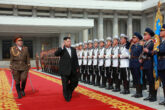September 20, 2018
China and America May Be Forging a New Economic Order
“New U.S.-China Tariffs Raise Fears of an Economic Cold War,” proclaimed a Washington Post headline. The New York Times alleged that the United States and China were already “on the cusp” of such a “new Cold War.” Driving this hysteria was the Trump administration’s Monday announcement unveiling tariffs on an additional $200 billion of Chinese imports, followed nearly immediately by a Chinese promise to retaliate. This back-and-forth has been ongoing since January, and a resolution does not seem anywhere close, if one’s even possible.
As the U.S.-China competition expands across multiple domains, there are even worries that trade tensions could, over the long term, make the prospect of a military confrontation between the two more likely. Which raises the urgent question: How does this end?
It’s perhaps simpler, and certainly more rhetorically arresting, to predict a new Cold War, resulting in a global economy split between two power centers. But the reality of where Washington and Beijing are most likely to arrive in the next decade is far more complex. The United States and China are forging a new, uncharted gray area—not quite the economic bifurcation that characterized the U.S.-Soviet relationship at the height of the Cold War, but far from the high degree of interdependence seen in the early-21st century. Broad U.S. support for a harder economic line on China, a complicated domestic political landscape within China, and both countries’ recognition of the need for a healthy diversification of their economic relations will likely mean a new kind of relationship for the United States and China—and, by extension, a potentially new backdrop for the order of our world.
Read the Full Article at The Atlantic
More from CNAS
-
Trump’s Audacious Success
This article was originally published in The Atlantic. Nicolás Maduro and his wife awoke yesterday in a safe house on a heavily fortified military base in the center of Caraca...
By Richard Fontaine
-
North Korea and Russia’s Deepening Axis
2025 was the year North Korea turned a corner, not just through provocations, but by actively repositioning itself in the global power game. Its military partnership with Russ...
By Dr. Go Myong-Hyun
-
CNAS Insights | Eight Things to Watch for in 2026
Buckle up for a pivotal geopolitical year. In 2026, the world will struggle to make sense of U.S. actions and intentions, and Washington will remain uncertain about its own pl...
By Richard Fontaine
-
North Korea in Motion: New Moves, Sharper Risks, and Shifting Regional Responses
As 2025 winds down, tensions on the Korean Peninsula are escalating once again.North Korea is sending thousands of workers to Russian drone factories, stepping up cyber theft ...
By Dr. Go Myong-Hyun




